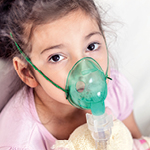Environmental toxins and disease
A sampling of research projects supported or assisted by the cross-disciplinary UC Davis Environmental Health Sciences Center
Respiratory health and toxins

UC Davis scientists study how air pollutants and social factors increase the risk and severity of asthma, chronic bronchitis and other respiratory illnesses, and work to discover and test new therapies.
Snapshot:
Wearable asthma trigger sensor
Problem: Asthma is more common and harder to control in regions with high pollution levels, but we don’t yet know the specific chemicals that trigger it.
Approach: Center members are developing a pen-sized, wearable sensor that provides detailed real-time data on the occurrence of bronchospasms in relation to environmental exposures. The insights could help lead to policy changes and treatments that protect children.
Principal Investigators: Cristina Davis, professor of mechanical and aeronautical engineering, College of Engineering, and Nicholas Kenyon, chief of pulmonary, critical care and sleep medicine, School of Medicine, with a $1.5 million NIH grant.
Endocrine, metabolism and toxins

Environmental chemicals that can interact and interfere with hormones are referred to as ‘endocrine disruptors.’ UC Davis researchers are studying these mechanisms, as well as the relationships between obesity, fats and environmental chemicals and how they increase diabetes and cancer risk.
Snapshot:
DDT, insulin resistance and type 2 diabetes
Problem: UC Davis researchers showed that exposure of pregnant mice to the now-banned pesticide DDT is linked to an increased risk of obesity, diabetes, high cholesterol and related conditions in female offspring later in life. Are humans similarly affected?
Approach: One center member is now studying whether exposure to DDT before birth could lead to insulin resistance in people during childhood, using a data set launched with Kaiser patients in the 1950s and ’60s. An ultimate goal is to develop a risk assessment in cooperation with state policy makers.
Principal Investigators: Michele La Merrill, assistant professor of environmental toxicology, College of Agricultural and Environmental Sciences, with a $1.3 million NIEHS grant. La Merrill was the first scholar selected to receive career-development funding, training and mentorship through the UC Davis Environmental Health Sciences Center.
Nervous system and toxins
Chemicals such as lead and mercury have long been recognized as harmful to the brain, but surprisingly little is understood about mechanisms of their toxicity. For many other chemicals in air, water, soil and products, gaps are much greater. But it is well-established that the gestational period is a particularly vulnerable window, Hertz-Picciotto said, and this is when those chemicals can threaten early brain development.
Snapshot:
How pesticides cross the blood-brain barrier
Problem: A network of blood vessels and tissue helps prevent many harmful substances (and therapies) from reaching the brain, but can still allow some to pass into the organ.
Approach: A center-funded study is using zebrafish to determine how pesticides commonly used in California can breach the blood-brain barrier and make the central nervous system susceptible to damage.
Principal Investigators: Lillian Cruz-Orengo of the Department of Anatomy, Physiology and Cell Biology in the School of Veterinary Medicine.
Measuring exposures

Several UC Davis researchers are investigating toxicant chemicals in air, water and breast milk to understand how they affect human systems.
Snapshot:
Measuring and analyzing chemicals in breast milk
Problem: While some women may have detectable levels of chemical agents in their breast milk, no established ”safe” or “unhealthy” levels exist to aid in clinical interpretation, investigators say. As a result, breast milk is not routinely tested for environmental pollutants.
Approach: Center-funded studies are measuring pesticide levels and analyzing concentrations of flame retardants and other environmental contaminants in human breast milk. A center-funded pilot study also looks for the antibacterial agent triclosan and other chemicals that interfere with hormones. Triclosan is used in some brands of personal-care products such as toothpaste and liquid hand soap.
Principal Investigators: Candace Spier Bever and Ameer Taha of the College of Agricultural & Environmental Sciences, and Birgit Puschner of the School of Veterinary Medicine.
Immune system and toxins

Disruption of immune system balance can interfere with developmental processes, compromise the body’s ability to respond to infections, or result in inflammation or autoimmunity. Past UC Davis research has shown links between specific air pollutants and susceptibility to infections, for instance, and demonstrated that the immune responses of children with autism may be more prone to inflammation when exposed to consumer flame retardants.
Snapshot:
Do environmental pollutants help trigger lupus?
Problem: Data is limited on how environmental factors affect human autoimmunity, a major factor in some 80 diseases.
Approach: A center pilot project is studying the effects of environmental pollutants on the immune function of patients with the classic and systemic autoimmune disease lupus erythematosus (SLE), to enhance understanding about how environmental factors may help trigger the disease and influence its effects.
Principal Investigators: Guo-Xiang Yang, Department of Rheumatology, Allergy & Clinical Immunology, School of Medicine.


